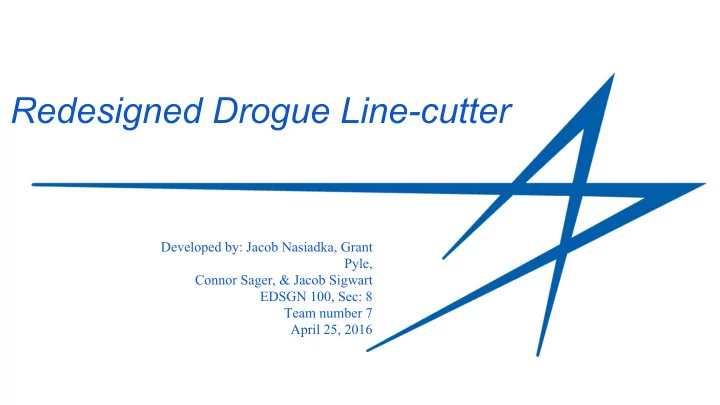

Redesigned Drogue Line-cutter Developed by: Jacob Nasiadka, Grant Pyle, Connor Sager, & Jacob Sigwart EDSGN 100, Sec: 8 Team number 7 April 25, 2016
Presentation Overview ● Recognizing the Problem and Project Selection ● Stakeholders and Problem Space ● Research and Current Design ● Solution Requirements and Technical Specifications ● Solutions ● Deciding on a Solution ● Simulations ● Final Design
Lockheed Martin gave us 5 different problems from which to choose. We selected: Problem #5. Problem Statement: We will select a Lockheed Martin Corp. product, part or component and redesign it to take advantage of additive manufacturing techniques. We will improve it by either reducing weight, reducing the part count, providing easier assembly, and/or improving performance. Fig. 1. Lockheed Martin Logo
We chose to redesign a component of the Orion Capsule. The specific mechanism will cut the drogue-parachute-lines upon reentry from space. Fig. 2. Orion Parachute Cutter
We studied the current design. Fig. 3. Diagram of cutter Fig. 4. SolidWorks rendering
There are eight parties who will be affected by this project. Fig 5. NASA Logo Fig 6. Penn State Students
The solution must follow certain design requirements and technical specifications. ● Must withstand the upward force from the drogue chute (96000 N each) ● Both parachutes must detach when the descent velocity =160 km/hr ● Mechanism must be able to operate under the flight conditions (up to 3g) ● Mechanical energy will be provided by NASA Standard Initiators Fig. 7. Technical Specifications
Lockheed Martin requires that we improve the design in at least one of the following areas: ● Mass of the current design ( Mass < 14.4 kg ) ● Number of parts (Part size < 23 parts) ● Physical size (Volume < 5,341 cm³) ● Manufacturing cost ● Assembly time Fig. 8. Orion Capsule Landing
We came up with two approaches that would take advantage of AM techniques to improve the design. ● Keeping with the basic design; combine several of the components on the existing design ● Devise a new method to cut the parachute-lines Fig. 10. AM Materials Fig. 9. Electron Beam Melting
Design #1: Reduced-part Design Features: ● Combines bolts, piston retainer, base, and several other parts ● Lower volume and mass Fig. 11. CAD rendering of Design 1
Design #2: No Shear-Pin Design Features: ● Incorporates more of the components into one part ● 3-D printed housing and blade ● Shear pins are replaced with a thin shell which will break-away Fig. 12. CAD model of Design 2
Design #3: No-cutter Design Features: ● No blade ● Pressure from the initiator cartridges will rotate the parachute anchor causing it to separate Fig. 13. No-cutter Design
We scored each potential solution based on how much it would improve upon the existing design. We considered: -Operational requirements -Number of parts -Cost savings -Ease of assembly -Performance Fig. 14. Weighted Decision Matrix
We selected design #1 to develop further. Fig. 15 . This design reduces the part count by combining many of the existing parts and in turn reduces the total mass and volume of the device.
We added a slot where the anvil plate can slide into place. Fig. 16 . Anvil is subject to large amounts of force during cutting sequence. Having an easy access to the part allows for a simple replacement in case of damage.
We refined the design to ensure the parachute tensile force would be distributed more evenly. Fig. 17. Initial deformation Fig. 18. Refined design deformation
We ran a series of simulations to prove that our new design could withstand all other forces. Fig. 19. Simulation of pressure in combustion chamber and its effect on the material. Fig. 18.
We selected Electron Beam Melting as the best AM process to produce our design. Uses an electron beam to fuse metal wire and powder together. Ability to print with metal provides device with needed structural strength. Fig. 20. Electron Beam
Comparisons between original design and new design. Original New Part Count 23 7 Volume 5341 cm³ 1025 cm³ Mass 14.4 kg 3.068 kg Fig. 22. New Design Fig. 21. Original Design
Final Design Features: -Mass: 3.068 Kg -7 parts -Volume of 1025 cm³ Fig. 23. CAD model of Final Design
References -http://www.glaad.org/blog/lockheed-martin-corp-will-no-longer-fund-boy-scouts-america -http://ntrs.nasa.gov/archive/nasa/casi.ntrs.nasa.gov/20100039628.pdf -Electron Beam https://www.google.com/url? sa=i&rct=j&q=&esrc=s&source=images&cd=&cad=rja&uact=8&ved=0ahUKEwjXw_K76aDMAhWKHD4KHVzSBPYQjRwIBw&url=http%3A% 2F%2Fwww.extremetech.com%2Fextreme%2F143552-3d-printing-with-metal-the-final-frontier-of-additive-manufacturing&bvm=bv.119967911,d. cWw&psig=AFQjCNF15tnmzSg2pOWccLvGo-Vq_t9zcA&ust=1461365602492157
Recommend
More recommend